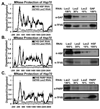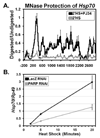Rapid, transcription-independent loss of nucleosomes over a large chromatin domain at Hsp70 loci
- PMID: 18614012
- PMCID: PMC2527511
- DOI: 10.1016/j.cell.2008.05.029
Rapid, transcription-independent loss of nucleosomes over a large chromatin domain at Hsp70 loci
Abstract
To efficiently transcribe genes, RNA Polymerase II (Pol II) must overcome barriers imposed by nucleosomes and higher-order chromatin structure. Many genes, including Drosophila melanogaster Hsp70, undergo changes in chromatin structure upon activation. To characterize these changes, we mapped the nucleosome landscape of Hsp70 after an instantaneous heat shock at high spatial and temporal resolution. Surprisingly, we find an initial disruption of nucleosomes across the entire gene within 30 s after activation, faster than the rate of Pol II transcription, followed by a second further disruption within 2 min. This initial change occurs independently of Pol II transcription. Furthermore, the rapid loss of nucleosomes extends beyond Hsp70 and halts at the scs and scs' insulating elements. An RNAi screen of 28 transcription and chromatin-related factors reveals that depletion of heat shock factor, GAGA Factor, or Poly(ADP)-Ribose Polymerase or its activity abolishes the loss of nucleosomes upon Hsp70 activation.
Figures






Comment in
-
Clearing the way for unpaused polymerases.Cell. 2008 Jul 11;134(1):16-8. doi: 10.1016/j.cell.2008.06.031. Cell. 2008. PMID: 18614004
References
-
- Adelman K, Marr MT, Werner J, Saunders A, Ni Z, Andrulis ED, Lis JT. Efficient release from promoter-proximal stall sites requires transcript cleavage factor TFIIS. Mol. Cell. 2005;17:103–112. - PubMed
-
- Albert I, Mavrich TN, Tomsho LP, Qi J, Zanton SJ, Schuster SC, Pugh BF. Translational and rotational settings of H2A.Z nucleosomes across the Saccharomyces cerevisiae genome. Nature. 2007;446:572–576. - PubMed
-
- Bortvin A, Winston F. Evidence that Spt6p controls chromatin structure by a direct interaction with histones. Science. 1996;272:1473–1476. - PubMed
Publication types
MeSH terms
Substances
Grants and funding
LinkOut - more resources
Full Text Sources
Other Literature Sources
Molecular Biology Databases

